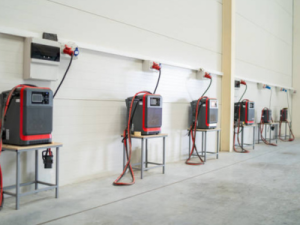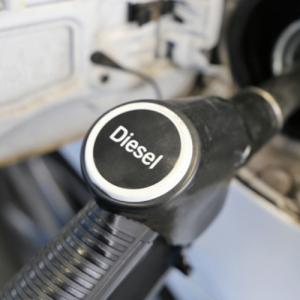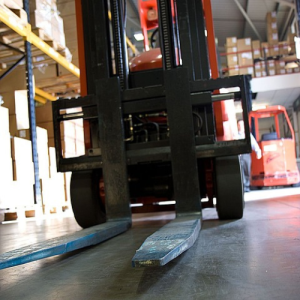Ever wondered about the powerhouse behind efficient warehouses and bustling construction sites? Meet the forklift, an unsung hero that keeps industries moving.
In this article, we’re going to take an in-depth look at what a forklift truck is, diving into its various uses, the mechanics behind its operation, and the multitude of types that exist. From warehouses to construction sites, these powerful machines are integral to countless industries, facilitating the movement of heavy goods with ease and precision.
What is a Forklift?
A forklift, also known as an industrial truck, lift truck, or fork truck, is a powered industrial vehicle designed to lift, move, and stack materials over short distances. It is equipped with two metal prongs (forks) at the front, which can slide under heavy loads for lifting and transporting. Forklifts are commonly used in various industries, including warehousing, manufacturing, and construction.
How Does A Forklift Work?
The Machine Itself: The forklift is usually powered by either an internal combustion engine or an electric motor. This power source not only propels the vehicle but also operates the hydraulic system that controls the lift. Forklifts use rear-wheel steering, which enhances manoeuvrability in tight corners. The operator controls the forklift using levers and a steering wheel.
The Lifting Mechanism: The lifting function of a forklift is controlled by its hydraulic system. When the operator pushes the lift control, it pumps hydraulic fluid into a cylinder, causing a piston inside to push upwards. This action raises the mast (the vertical assembly) and the forks, lifting the load they carry. A pulley system or chain linked to this assembly allows the forks to move vertically while remaining level, ensuring load stability.
Additionally, a counterweight at the rear of the forklift balances the weight of the load being lifted, preventing the forklift from tipping over. The front wheels act as a balance point, much like a seesaw. The forklift also usually has a tilt mechanism that allows the mast to tilt slightly backward or forward, assisting in maintaining load stability during transport and accurate placement when stacking.
Find Your Perfect Forklift
Compare Quotes from Local Forklift Dealerships


Enter Requirements


We Find the Best Deal


Receive your Quote
A Quick History of Forklifts
 The history of the forklift is a fascinating journey that begins in the late 19th century. The first iterations were quite different from the machines we know today. Initial efforts to combine horizontal and vertical motion emerged around the end of the 1800s, with a crude truck capable of lifting its platform a few inches.
The history of the forklift is a fascinating journey that begins in the late 19th century. The first iterations were quite different from the machines we know today. Initial efforts to combine horizontal and vertical motion emerged around the end of the 1800s, with a crude truck capable of lifting its platform a few inches.
The real landmark event occurred in 1917 when the Clark Material Handling Company introduced the Tructractor, often regarded as the original forklift. This vehicle, designed specifically for warehouses and factories, was the first seated counterbalanced truck.
In 1922, Miag developed the world’s first “lift-up” forklift, which became the predecessor of the modern forklift. As the years passed, the design and functionality of these machines evolved, leading to the advanced, versatile forklifts we see in industries around the world today.
From their humble beginnings as basic lifting machines, forklifts have transformed into indispensable tools in global industry, helping businesses move and manage materials efficiently and safely.
The Different Types Of Forklifts
Forklifts come in a variety of types and designs, each tailored to serve specific purposes and environments. Here are some of the most common types you’ll encounter:
Counterbalance Forklifts: These are the most common type of forklift. They have a counterweight at the back to balance the load at the front and can operate on smooth surfaces both indoors and outdoors.
Electric Forklifts: These are powered by large, lead-acid batteries. Electric forklifts are perfect for indoor use because they don’t emit harmful fumes and are quieter than their internal combustion counterparts.
IC (Internal Combustion) Forklifts: These forklifts run on various fuels, including gasoline, diesel, and propane. They are powerful machines that excel in outdoor settings and can lift heavy loads.
Reach Trucks: Specifically designed for warehouse operations, reach trucks have extended lift heights and are best suited for high rack loading and tight spaces.
Pallet Jacks: Also known as pump trucks or pallet trucks, these are low-lift trucks designed to move palletized loads. They are ideal for loading and unloading trucks, as well as moving goods around warehouses.
Order Pickers: These are used in warehouses to hand-pick items from racking and bring them down to ground level.
Telehandlers (Telescopic Handler Forklifts): These are essentially forklifts with a boom lift. Telehandlers have extendable arms, making them perfect for reaching into or over obstacles and structures.
Rough Terrain Forklifts: With oversized, aggressive tread tires, these forklifts are designed to operate on uneven and rocky surfaces, making them ideal for construction sites.
Each type of forklift has its unique advantages and is designed to improve efficiency and safety in its respective applications. We have a full guide on the different types of forklifts which delves deeper into the specifics of each model, their ideal usage scenarios, and safety measures to be taken while operating them.
The Different Forklift Power Sources
Forklifts are powered by three main fuel types: electric, diesel, and LPG. Each fuel type offers unique advantages and considerations, playing a vital role in the machine’s performance, suitability for different environments, and overall cost-effectiveness.
We have a great guide on the costs and benefits of different forklift fuel options, that goes into detail about the initial investment required for each type, their running costs, the impact on the environment, and maintenance requirements.
Electric Forklifts
 Electric forklifts, powered by rechargeable batteries, are a great choice for indoor operations due to their zero emissions and quiet operation. They come with either lead acid or lithium-ion batteries, each with unique advantages and considerations. While the initial investment may be higher, the long-term value can be better due to lower fuel costs.
Electric forklifts, powered by rechargeable batteries, are a great choice for indoor operations due to their zero emissions and quiet operation. They come with either lead acid or lithium-ion batteries, each with unique advantages and considerations. While the initial investment may be higher, the long-term value can be better due to lower fuel costs.
Diesel Forklifts
 Diesel forklifts are robust and adaptable to various weather conditions, making them versatile for different operational environments. Despite their high performance, they are generally noisier and less environmentally friendly compared to electric forklifts. However, they are suitable for heavy-duty tasks and outdoor use.
Diesel forklifts are robust and adaptable to various weather conditions, making them versatile for different operational environments. Despite their high performance, they are generally noisier and less environmentally friendly compared to electric forklifts. However, they are suitable for heavy-duty tasks and outdoor use.
LPG Forklifts
 LPG forklifts strike a balance between power and cleanliness, making them suitable for both indoor and outdoor use. They offer longer run times compared to electric forklifts but require a dedicated storage area for gas cylinders. The running costs of LPG forklifts should be considered in terms of fuel prices, cost per kilometre, efficiency, and maintenance.
LPG forklifts strike a balance between power and cleanliness, making them suitable for both indoor and outdoor use. They offer longer run times compared to electric forklifts but require a dedicated storage area for gas cylinders. The running costs of LPG forklifts should be considered in terms of fuel prices, cost per kilometre, efficiency, and maintenance.
The Main Parts Of A Forklift
Understanding the physical components of a forklift is essential to fully grasp how these machines operate and perform their tasks efficiently. Each part has a specific function and contributes to the overall performance and safety of the forklift. In this section, we will delve into the key components of modern forklifts.

Forklift Tires And Wheels
The tires and wheels of a forklift are vital components that directly impact the machine’s stability, safety, manoeuvrability, and even its lift capacity. Forklift tires come in three main types: pneumatic, solid rubber, and polyurethane.
Pneumatic Tires: Sometimes called cushion tires are similar to traditional car or truck tires, pneumatic tires are air or foam-filled, offering durability and excellent traction. Ideal for rough outdoor terrains, these tires also contribute to a higher lift capacity due to their size and air cushioning, which provides better stability.
Solid Rubber Tires: These tires are solid, not filled with air, and thus immune to punctures or deflation. While they may not provide as much cushioning or lift capacity as pneumatic tires, they are reliable for indoor use or on smooth surfaces where puncture risks are low.
Polyurethane Tires: Press-on tires known for providing a smooth ride, polyurethane tires have great traction and low rolling resistance, making them perfect for indoor applications. They typically don’t contribute as much to lift capacity as pneumatic tires but offer efficient operation.
The choice of tire significantly affects a forklift’s performance and lifting capabilities. Therefore, it’s essential to consider the operating environment and lifting needs when selecting the right tire type for your forklift.
The Different Forklift Mast Types
The mast is a critical component of a forklift, responsible for raising, lowering, and tilting the load. There are several types of forklift masts, each designed to meet specific operational requirements.
Standard Mast: Also known as an upright mast, this is the most common type. It has two stages, allowing the forks to lift loads to a certain height.
Duplex Mast: A duplex mast, or a two-stage mast, has additional lift height compared to a standard mast. It’s ideal for situations that require higher lifting without concern for low clearance.
Triplex Mast: The triplex mast, also known as a three-stage mast, offers even greater lift heights. It has three sections, enabling it to reach higher while maintaining a low closed height for navigating areas with low clearance.
Quad Mast: The quad mast, or four-stage mast, provides the greatest lift height of all. It’s designed for specialised applications that require reaching extremely high locations.
Hydraulic Cylinders and chain pulleys
Playing a vital role in the operation and functionality of forklifts, hydraulic cylinders and chain pulleys are integral to the forklift’s performance and efficiency.
Hydraulic Cylinders
Hydraulic cylinders come in two primary types: single acting and double acting. While the former applies force in a single direction, the latter can exert force in both directions. These devices lend their strength to forklifts, enabling them to lift and transport heavy loads with precision and control.
Chain Pulleys
Chain pulleys on forklifts are an integral component that contribute significantly to their lifting capacity. These pulleys, often referred to as chain sheaves, guide and support the lift chain in the forklift’s mast. They work in tandem with the hydraulic system, enabling the forklift to lift and lower heavy loads with accuracy and control.
Forklift Attachments
 Forklift attachments are additional tools or accessories that can be added to a forklift to extend its functionality. While they are not originally part of the base forklift, these attachments can significantly enhance the versatility and efficiency of the machine.
Forklift attachments are additional tools or accessories that can be added to a forklift to extend its functionality. While they are not originally part of the base forklift, these attachments can significantly enhance the versatility and efficiency of the machine.
They can transform a standard forklift into a multi-purpose vehicle capable of handling various tasks beyond just lifting and transporting heavy loads. Examples of forklift attachments include:
- Side Shifters
- Fork Positioners
- Clamps
- Rotators
- Fork Extensions
The Most Common Uses of Forklifts
Forklifts are an essential tool in many industries, primarily for moving materials. Here are some of the most common industrial uses of forklifts:
- Warehouses and Distribution Centres: Forklifts are heavily used in warehouses and distribution centres for shipment handling. They are instrumental in loading and unloading trucks and transporting goods around the storage facility.
- Construction Sites: Another common use of forklifts is on construction sites. Due to the heavy objects and building materials that need to be moved around, forklifts play a crucial role in these environments.
- Manufacturing and Industrial Operations: Forklifts are also used widely in manufacturing and industrial operations. These can range from small businesses to large complex industrial operations where they aid in moving materials of different sizes and weights.
- Shipping Ports and Truck Loading/Unloading: Forklifts are often used at shipping docks and during truck loading and unloading processes. They help move large containers and other heavy items quickly and efficiently.
- Recycling Facilities: Forklifts play a crucial role in recycling operations where they are used to move and organise heavy bales of compacted recyclables, load and unload delivery vehicles, and assist with the general maintenance and organisation of the facility. Their ability to handle heavy loads makes them an invaluable tool in these environments.
- Event Venues and Film Sets: Forklifts are often used in setting up and tearing down events at concert venues, theatres, or film sets. They can move heavy equipment like speakers, stage sets, lighting rigs, and even portable seating. This helps to make the setup and breakdown processes much quicker and more efficient, especially when dealing with large-scale events or productions.
The Benefits Of Forklifts
Forklifts are a vital part of many industries, offering numerous benefits that improve efficiency, productivity, and safety. Here are the key benefits of using forklifts:
Increased Efficiency: Forklifts can move large and heavy loads much more quickly and efficiently than manual labour. This significantly speeds up work processes, particularly in warehouses and manufacturing facilities.
Improved Safety: When used correctly, forklifts can make the workplace safer. They are designed to carry heavy loads securely, reducing the risk of injuries related to lifting and moving heavy items.
Versatility: Forklifts can be used in a variety of tasks beyond just lifting and moving items. They can also be used for digging, snow ploughing, and even lifting workers to higher areas with the right attachments.
Cost Savings: By improving efficiency and productivity, forklifts can lead to significant cost savings. They enable fewer workers to move more goods in less time, reducing labour costs.
Ease of Use: Modern forklifts are designed with ergonomic controls, making them relatively easy to operate once proper training has been received.
Durability and Longevity: Forklifts are built to last, capable of operating in tough conditions and handling heavy loads for many years when properly maintained.
Variety of Types and Sizes: From compact electric models suitable for light indoor work to robust diesel models designed for heavy lifting in difficult outdoor conditions, there are forklifts available to suit virtually any requirement.
The Basics of Forklift Safety
Forklift safety is of paramount importance in any workplace where these machines are used. Here are some basic principles that should always be adhered to in order to ensure a safe working environment:
Proper Training and Certification: Before operating a forklift, workers should undergo proper training and obtain certification as required by OSHA (Occupational Safety and Health Administration). This ensures they understand how to operate the machine safely and are aware of potential hazards.
Regular Maintenance and Inspections: Forklifts should be regularly serviced and maintained to ensure they are in good working condition. Operators should also perform daily inspections to check for any issues before starting the machine.
Safe Load Handling: Overloading or improper loading can lead to accidents. Operators should always adhere to the manufacturer’s load capacity guidelines and ensure loads are stable and evenly distributed.
Operating at Safe Speeds: Forklifts should be driven at a speed that is safe for the current conditions, which includes taking into consideration the type of load, pedestrian traffic, and floor conditions.
Use of Seatbelts: Operators should always wear seatbelts while operating a forklift. In the event of a tip-over, a seat belt can save the operator’s life by keeping them within the protective frame of the forklift.
Pedestrian Awareness: Forklift operators should always be aware of their surroundings, particularly pedestrians who may not be familiar with the operation of forklifts. Clear communication and designated pedestrian areas can help maintain safety.
Remember, the key to forklift safety is a combination of proper training, regular maintenance, and mindful operation. If you want more information on forklift safety read our post on 17 Must-know Forklift Safety Tips to Avoid Catastrophe.
How To Choose A Forklift
Choosing the right forklift for your business is a crucial decision. The wrong machine can cause inefficiencies in operations, increased maintenance costs, and potential safety hazards.
Conversely, making the right choice can enhance productivity, reduce operational costs, improve safety standards, and ultimately contribute to the overall success of your business. It’s all about finding a balance between your specific needs and the features that a particular forklift offers.
We have a comprehensive forklift buyer’s guide that walks you through every aspect of choosing the right forklift for your business. But to give you a quick overview, here are the top six considerations:
- Load Capacity: Assess your operational needs to determine the required load capacity.
- Lifting Height: Align the lifting height with your specific requirements.
- Fuel Type: Choose the appropriate fuel type based on indoor or outdoor usage, space constraints, and environmental considerations.
- Operator Comfort: Ensure operator comfort to enhance efficiency.
- Site Specifics: Take into account factors like the narrowest space and daily operating hours.
- Environment Compatibility: Make sure to match the forklift with its intended working environment and tasks.
Conclusion
In conclusion, a forklift is an indispensable piece of machinery in many industries, from manufacturing to warehousing. Its primary function is to lift and transport heavy materials over short distances, making operations more efficient and safe.
The versatility and power of a forklift can greatly enhance productivity, but it’s crucial to select the right one that fits your specific needs and business environment. As we’ve explored in this article, understanding what a forklift is goes beyond its basic definition – it’s about recognizing its potential impact on your operations!